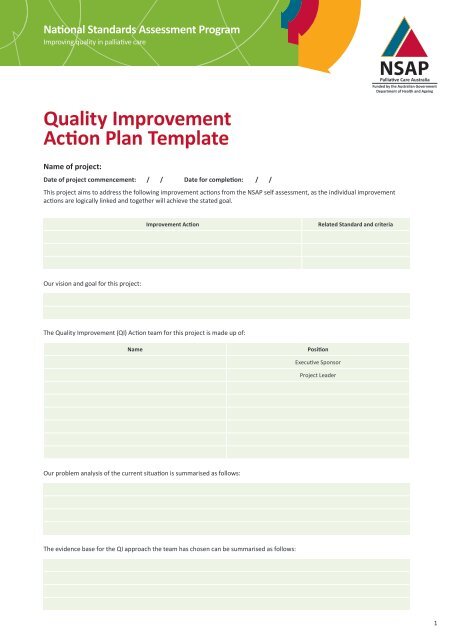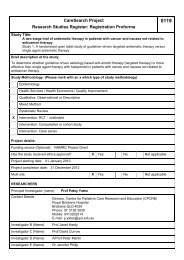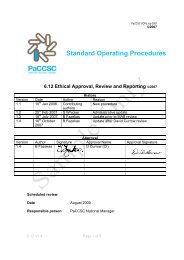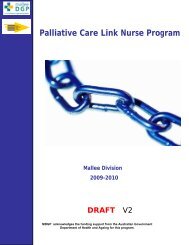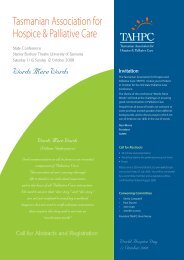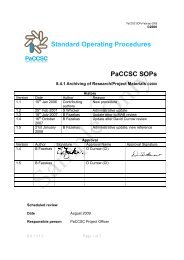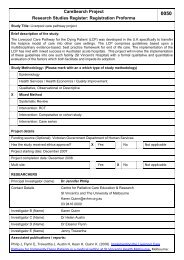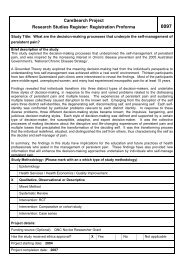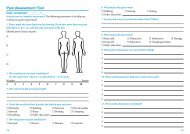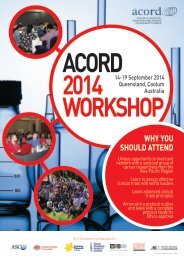NSAP QI action plan template - CareSearch
NSAP QI action plan template - CareSearch
NSAP QI action plan template - CareSearch
Create successful ePaper yourself
Turn your PDF publications into a flip-book with our unique Google optimized e-Paper software.
National Standards Assessment Program<br />
Improving quality in palliative care<br />
Quality Improvement<br />
Action Plan Template<br />
Name of project:<br />
Date of project commencement: / / Date for completion: / /<br />
This project aims to address the following improvement <strong>action</strong>s from the <strong>NSAP</strong> self assessment, as the individual improvement<br />
<strong>action</strong>s are logically linked and together will achieve the stated goal.<br />
Improvement Action<br />
Related Standard and criteria<br />
Our vision and goal for this project:<br />
The Quality Improvement (<strong>QI</strong>) Action team for this project is made up of:<br />
Name<br />
Position<br />
Executive Sponsor<br />
Project Leader<br />
Our problem analysis of the current situation is summarised as follows:<br />
The evidence base for the <strong>QI</strong> approach the team has chosen can be summarised as follows:<br />
1
The following data will be collected, and will include: baseline measures of the current situation; comparative measures to<br />
demonstrate improvement; data about any unanticipated change; data to assure that the project is implemented as intended;<br />
and, data that will be used in the project’s evaluation:<br />
Type of data Who will collect this How often Method of collection<br />
The team will communicate progress and manage the change as follows:<br />
Stakeholder group Frequency of communication Method of communication Person responsible<br />
2
Detailed Action Plan and Progress Record for project.<br />
Note: A high level progress report against the Plan can be recorded in the final column of the table below, as the project is implemented.<br />
Goal statement:<br />
Objective Strategy By whom By when Measures of success Progress to date<br />
Specific evaluation questions:<br />
3
Notes for completion of the Detailed Action Plan<br />
The goal statement is the concise working description of the vision and goal documented in p. 1 of this project <strong>plan</strong>.<br />
Each objective could be seen as a sub-goal, to be achieved in a Plan, Do, Study, Act (PDSA) cycle. This may or may not align clearly<br />
with an identified improvement <strong>action</strong> from the self assessment, but will be an important milestone to be achieved if the overall<br />
goal is to be achieved.<br />
All strategies required to achieve each of the objectives should be listed. This should include change management and evaluation<br />
strategies.<br />
In the ‘by whom’ column, include the name of the role with key responsibility for implementing this strategy.<br />
In the ‘by when’ column, consider inter-relationships of the different strategies when defining all timelines, external factors which<br />
might impact on the project and a realistic allocation of effort for the tasks involved.<br />
Measures of success are the indicators that demonstrate achievement of each key strategy/milestone as the project progresses;<br />
each of these measures should be included in the data section on p.1 of the project <strong>plan</strong>, or be able to be calculated from this data.<br />
In the progress to date section, include all progress, both the positive and the negative. Consider whether learnings about<br />
the process of C<strong>QI</strong> should be noted here or elsewhere, but do not lose this intelligence, as it will inform future C<strong>QI</strong> project<br />
development, implementation and evaluation.<br />
In the specific evaluation questions section, consider both process (or formative) and outcome (or summative) questions, so that<br />
the team can assess the value of the project – in terms of outcomes (for consumers, staff, the team and the Service), in terms of<br />
the <strong>QI</strong> and change management process in which they have participated, and in terms of learnings to take forward into future<br />
projects. Check to ensure that the data required to answer the evaluation questions is included in the data section on p. 1 of the<br />
project <strong>plan</strong>, and that strategies are included in the detailed <strong>plan</strong> to enable the team to answer the evaluation questions.<br />
Funded by the Australian Government Department of Health and Ageing<br />
For further information contact the <strong>NSAP</strong> team on:<br />
T: +61 2 6163 8419 F: +61 2 6232 4434 E: nsap@palliativecare.org.au W: www.palliativecare.org.au 4


